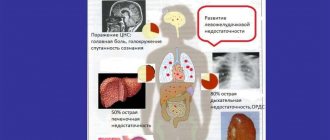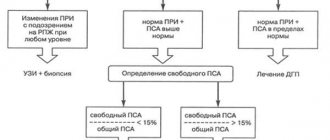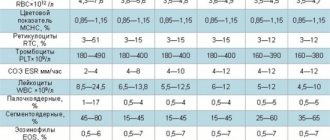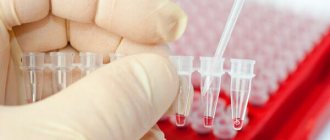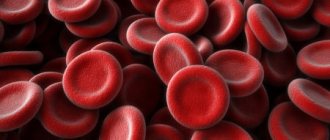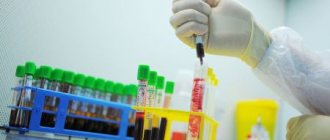What is RW blood test
A special category of medical tests includes blood tests for RW, or the Wassermann reaction. This technique detects markers of syphilis in the blood and determines how much time has passed since infection (after contact with a carrier of the infection). Today, donating blood for RW is the only way to diagnose the latent form of the disease. The reliability of the analysis influences the treatment program, the result of which determines the patient’s quality of life.
Syphilis is a chronic venereal disease caused by the pathogen Treponema pallidum. Characterized by the manifestation of ulcers on the skin and mucous membranes. With timely diagnosis, syphilis can be successfully treated with immunomodulatory drugs. The RW analysis determines the causative agent of syphilis and specific antibodies to it produced by the human immune system.
Indications for donating blood
Patients may be prescribed a serological blood test in the following cases:
- during a routine medical examination;
- when registering for pregnancy;
- if venereology or AIDS is suspected;
- after unprotected sexual intercourse (HIV testing);
- donors before donating biomaterial (sperm or blood);
- upon admission to hospital for treatment;
- serving sentences in penal colonies;
- to control the activity of the infectious agent during treatment;
- when varicose veins or lupus erythematosus are detected.
To identify infected people and prevent further spread of infection, the following categories of citizens must undergo a blood test for RW:
- employees of medical institutions;
- drug users;
- industrial workers.
Symptoms for which a blood test for infection is prescribed:
- low-grade fever;
- long-term pain in the bones;
- ulcers and tissue damage near the genitals;
- unusual discharge in women;
- skin rash;
- enlarged lymph nodes.
Indications for analysis
Medical workers, employees of cosmetology and dermatology offices, and food workers are required to donate blood for RV. Other indications for a specific test are:
- pregnancy planning;
- preparation for operations;
- unprotected sex (especially with a new partner);
- suspicion of sexually transmitted infections;
- blood or sperm donation;
- the appearance of an incomprehensible rash on the mucous membranes and skin, discharge from the genitals, disruption of the menstrual cycle in women;
- visible enlargement of lymph nodes (especially in the groin area).
What does a negative syphilis test mean?
For most people, this is evidence of the absence of a syphilitic infection.
A negative analysis is a reason to rejoice.
There is a high probability that you are healthy and do not need further visits to the doctor.
Most often, people who do not have symptoms of this disease take tests for syphilis.
This is done for preventive purposes.
There are different reasons for getting tested:
- pregnancy
- upcoming surgery
- identifying other STDs
- medical examination of workers in the food, water industry, health care or education systems
But in any case, detecting a syphilitic infection is much less likely than the chance of getting a negative result.
People often get confused about what the word “negative” means.
For some, this is a sign of negativity.
That is, the tests are “bad”.
This means that they may indicate the presence of syphilis.
At the same time, the word “positive” is often associated with something good.
But in reality the opposite is true.
A positive test means that a syphilitic infection has been detected.
Negative means no signs of infection.
How to take a blood test for RW
A blood test for RV is taken on an empty stomach - at least six hours must pass between meals and the laboratory test. Tests in an adult are taken from the ulnar vein, in an infant - from the cranial or jugular vein. The patient is seated on a chair or laid on a couch, a vein is pierced and 8-10 ml of blood is taken and sent for testing. After collecting the material, proper nutrition and plenty of fluids are recommended (it is better to prefer hot sweet tea). On this day it is better to avoid physical activity and alcohol.
blood test for Wasserman reaction during pregnancy
From the 5th week, the uterus enlarges and the doctor can already determine the duration of pregnancy . Do not delay your visit to the antenatal clinic; you need to undergo a series of laboratory tests.
In the 2nd month, the so-called subjective signs of pregnancy - you have probably already noticed a change in your taste preferences, and some people have fallen in love with sour or salty foods. Many people experience nausea in the morning. This is normal: from the 5th week, the hormonal balance in your body changes. Before that, the level of sex hormones (estrogens and progesterone) was the same as in the second phase of the menstrual cycle, which is familiar to you. At week 5, it increased significantly, as the development of the corpus luteum of the ovary (at the site of the fertilized egg) reached its peak. In addition, the adrenal cortex is now working very intensively - an additional source of hormones.
Critical periods
7th week of pregnancy . One of the most difficult! This is a kind of milestone, a test of the strength of the relationship that by this time has developed between the mother’s hormonal production and the developing placenta. Most spontaneous miscarriages in the first trimester occur in the 7th week.
Why is this happening? If by the 5th week of pregnancy the corpus luteum has developed and “worked” to its maximum, then by the 7th week of pregnancy it fades away and produces much less progesterone and estrogens. And these hormones now play an extremely important role in the development of the fetus. Instead of the corpus luteum, their pregnancy determined by how much the placenta has “mature” and is ready to take on new functions. If its development was normal in the previous weeks, the difference in hormone levels will be short, and your body will cope. If the conditions for the formation of the placenta have been violated, it cannot take on new functions by the required time, and the decline in hormone levels is delayed, and the normal development of the fetus is disrupted. This is a real threat of miscarriage.
Laboratory tests at the 2nd month
1. Vaginal smears.
2. Blood test for HIV and Wasserman reaction (syphilis).
3. General blood and urine analysis.
4. Urine for the determination of hCG (chorial gonadotropin): its level determines whether the pregnancy is proceeding favorably.
5. Hemostasiogram (assessment of blood clotting ability), if there have already been complications in the past (miscarriages, fetal growth retardation, death of the child)
Despite the fact that pregnancy is a natural physiological process, it places a huge burden on a woman’s body: chronic diseases worsen, and diseases that you did not suspect about may appear.
Food and rest in the 2nd month
The main thing is rationality. Lots of vegetables and fruits. Boiled meat, boiled fish - you need proteins! Lactic acid products, but not milk itself - it can cause intestinal problems.
Don’t put smoked or fried food on your table. Salty foods are still allowed in the first trimester (the first three months), but then you will have to exclude them. So train yourself to eat less salty foods now.
You can take multivitamins for pregnant women, but you don’t need special medications (calcium, for example) yet.
If you work, then right now you should take a leave of absence and devote it to yourself and your future baby: walk more in the fresh air, enjoy nature, try to avoid excessive stress, exposure to harmful substances, polluted atmosphere, etc.
If possible, you should avoid working with a computer or reduce it to a minimum, since it has been established that combined exposure to several types of radiation can be harmful to the health of pregnant women.
Relatives and friends of a pregnant woman should surround the expectant mother with care and attention, maintain a calm and supportive environment, and avoid stressful situations. In order for a child to be born healthy, his mother must be protected from conflicts, unpleasant experiences, mental overloads, and the most calm and healthy conditions must be created for her.
Fetus
In the second month, the embryo is especially sensitive to all kinds of damaging Factors.
5th week of pregnancy . By day 35, the nose and upper lip begin to form. If at this time the normal development of the fetus is disrupted, the buds may not grow together as expected, and the child will be born with a “cleft lip.”
6th week of pregnancy . The “construction” of the placenta is almost complete, and connections with the maternal body are finally established.
Nature “sculpts” the face more and more clearly and clearly: the formation of the eyes, nose, upper and lower jaw continues.
The arms and legs are growing, but there are no fingers on them yet.
The most important organ of the immune system, the thymus gland, was formed. It is larger than all the endocrine glands combined. Its role at this point has not been thoroughly clarified, but we can confidently assert the extreme importance of the thymus gland for the development of the fetus: apparently, the thymus gland itself carries out immunological supervision of the developing cells of the child or takes an active part in this process.
7th week of pregnancy . The structure of the heart improves: partitions and large vessels are formed, the heart becomes four-chambered. Bile prophets have already appeared in the liver, and the endocrine glands are developing at a rapid pace.
The brain grows and develops. The ears have taken shape and fingers have appeared on the limbs. The embryo is already moving, but is still too small for the mother to feel these movements.
8th week of pregnancy . The most intensive process of development of external and internal organs, especially the genitals. Until 8 weeks, it was impossible to determine gender by appearance. Now, under the influence of Y-chromosome genes, male gonads (testes) are formed in boys and begin to produce testosterone, the male sex hormone. And in girls, the external genitalia have not yet changed.
The size of the embryo at the end of the second month is 3 cm.
Decoding
The results form includes pluses or minuses. The latter speak of a negative reaction and absence of illness. A positive reaction can be described with one to four plus signs. The transcript shows the stage of the disease:
- ++++ or +++ – positive test;
- ++ – weakly positive;
- + – doubtful, requires re-checking.
If the RW analysis shows a negative result, this does not exclude that a person has syphilis at the first or third stage. Plus, a negative reaction may indicate the destruction of red blood cells. The secondary period of syphilis does not always show a positive result. In the first 17 days the reaction may be negative, and only by the sixth week it may show ++++, and even then only in 25% of patients with syphilis. After this, the reliability approaches 80%. Approximately 5% of healthy people show a false positive result.
RV test is positive
If the test for RV is positive, this indicates the presence of antibodies to Treponema pallidum in the blood - that is, about 1.5 months have passed since the infection. Other reasons for the appearance of ++++ on the results sheet are:
- carrying out antisyphilitic therapeutic measures - reducing the acute process;
- pregnancy in the absence of the disease itself - the analysis will be weakly positive in approximately 1.5% of women;
- primary syphilis – 80% of cases at 6-8 weeks;
- secondary syphilis in 100% of cases;
- clinical relapse of the disease;
- tertiary period of the disease - in 75% of cases;
- early congenital syphilis.
RW negative
If you receive a negative test result, you can talk about the absence of infection and antibodies to syphilis in the body, but this is not always the case. In the early stages of the disease, the results will be negative because antibodies simply do not have time to develop. Plus, certain diseases and individual characteristics of patients influence the reliability failure.
Donating blood to RV
Before doing RW analysis, you need to follow a number of simple rules. Before visiting the clinic, it is not recommended to take medications that can cause allergies and endure significant physical or emotional stress. All of these factors lead to the fact that the result of the RW study is incorrect. As a rule, the procedure is carried out in the morning, on an empty stomach.
Blood can be donated for RW in any modern hospital or private laboratory. The price of the procedure is about 150-500 rubles. How much the analysis will cost depends on the level of the clinic, region and location of the institution. Private laboratories provide results in a shorter time; it is also possible to send them to the patient’s email. This greatly simplifies the life of citizens and saves time.
After the biomaterial is collected from the patient, it is examined. The process takes about two days. If the RW test is negative, this does not provide a reliable answer as to whether there is an infection in the body. The initial stage of development of some diseases is characterized by the destruction of red blood cells, which may cause antibodies to not be detected in the first 17 days after infection. If the result is positive, the patient is referred for a more thorough examination, after which the doctor must make an accurate diagnosis.
Where is the blood taken from?
Theoretically, the material for RW research can be blood taken from a finger and a vein. The reliability of the analysis depends on many nuances. For example, blood from a finger is examined using the microprecipitation reaction method. In this case, the presence of antibodies is determined very quickly. However, one cannot be completely sure of their specificity. Any proteins that are synthesized in significant quantities during allergies or infectious processes are classified as antibodies that RW detects. Therefore, for more reliable data, blood is taken from a vein from the patient.
How long does it take to test for syphilis?
The time it takes to receive data depends on how busy the clinic’s laboratory is. As a rule, during routine examinations, patients receive results within 48 hours. However, there are special circumstances when a person arrives with serious injuries, pain, bleeding and requires urgent surgery. The procedure for such patients cannot take more than a few hours.
False positive reaction
In 5% of patients, a false positive reaction is observed - a condition when the analysis shows ++, but the patient is not sick. The reasons for a false positive manifestation are:
- tuberculosis, systemic lupus erythematosus, leukemia, leprosy, leptospirosis, cancer, typhus, scarlet fever, HIV and AIDS;
- beriberi and sleeping sickness, hepatitis;
- in pregnant women or those who have just given birth;
- during menstruation;
- after anesthesia, consumption of alcohol, drugs, fatty foods, coffee, cigarettes, medications, administration of certain serums or vaccination;
- acute infections in pregnant women.
Positive result
However, the decoding of this advantage is not so obvious. There is always the possibility that a false reaction occurred and the result is unreliable. So, the following reasons may be accomplices of the false positive reaction that occurred.
- If the patient has an established diagnosis of tuberculosis.
- If he is being treated or has recently been treated for pneumonia.
- If there is rheumatic inflammation of the joints.
- If any vaccinations were given the day before.
- If the patient is an addicted drug addict or alcoholic not in remission.
- Sometimes (very rarely) if the suspected patient abuses fatty foods.
- When diagnosed with diabetes mellitus.
- During pregnancy, or blood was taken during menstruation.
- If blood is taken from a newborn in the first ten days of his life.
- For viral hepatitis.
- In the presence of oncology or benign formations.
Despite so many factors that give a false positive result, the Wasserman reaction is still used by doctors. Remember that a positive RW result remains for a year after remission if you have treated the virus previously.
What to do if RW is positive
If the obtained data show ++++ or ++, a secondary blood sampling is necessary. Sometimes ORS (disease selection response) is used. To do this, blood serum is applied to a glass slide and a cardiolipid antigen is added. If the repeated result is positive, a visit to a venereologist is required to make an accurate diagnosis.
To prevent congenital syphilis in children, pregnant women donate blood for RW during all nine months: this test is one of the mandatory procedures for expectant mothers. If a pregnant woman becomes infected, comprehensive treatment is necessary during the first months. If treatment is neglected, the consequences are dangerous for both the mother and the unborn child.
The essence of the method and its diagnostic value
Syphilis is an insidious disease. For a long time after infection, it is impossible to detect any manifestations not only at home, but also during a hospital examination. A person who has been infected with syphilis as a result of contact with a sick person does not suspect it for a very long time - and he himself is a carrier of the disease, infecting others, who, in turn, also get sick and become infectious. Such a chain reaction at one time was simply the scourge of our time, and doctors simply did not understand how to stop such a spread of the disease, which in some places resembled an epidemic. Concerned with this issue, Wasserman began to study the blood of those who had been diagnosed with syphilis. After a long analysis, it turned out that paired complexes, which are in the blood of patients, but not in the blood of healthy people, are attracted by the pathogen. This is a natural reaction of the body, which begins to protect itself - paired complexes, together with accompanying components, prevent hemolysis from occurring as a result of infection (the breakdown of red blood cells). It is these structures that “find” and determine the RW of the blood. Healthy people simply do not need such structures - without the virus, red blood cells are not in danger.
Thus, the Wasserman reaction is an analysis that reveals the presence of specific structures that are formed only in the presence of the syphilis virus in the blood, and are always detected if the virus itself is present. The severity of hemolysis varies and allows for gradation according to the established classification in pluses from one to four. We'll talk more about what this means below.
Price
You can donate blood for RW in private clinics or district hospitals. When undergoing a medical examination under the compulsory medical insurance policy, the patient has the right to a free analysis during the initial examination. In private clinics in Moscow prices will be:
| Service name | Price range, rubles |
| Fasting blood collection or repeated donation | 199-300 |
| Flocculation test | 370-500 |
| Test for the presence of antibodies to spirochete pallidum | 400-500 |
| PCR test | 500-800 |
Is a negative test always a reason to rule out syphilis?
There are tests for infections that always give reliable results.
If a bacteria or virus is detected, this indicates that the person is sick.
The opposite is also true: if there is no infectious agent, there is no disease.
With syphilis, everything is much more complicated.
The problem with this infection is that it very often occurs in a latent form.
There are no significant symptoms during certain periods.
There is no syphiloma containing bacteria.
Therefore, their direct detection is impossible.
Serological tests have to be done.
But these tests are not as accurate when compared with direct methods for detecting the pallid spirochete.
They detect not the bacteria themselves, but antibodies.
Moreover, these are not always immunoglobulins to the causative agent of syphilitic infection.
Tests are often used to detect Igs produced in response to damage to the body's own tissues (reagin antibodies).
Thus, it is not the pale spirochete that is found in the blood, but only “evidence” of its presence in the body.
But they are not absolute.
It happens that the result is positive and the person is healthy.
The opposite situations also happen: the test for syphilis is negative, and the patient suffers from a syphilitic infection.
Such cases are more dangerous from an epidemiological point of view.
Because a person who receives positive results is examined further.
And if he is not really sick, the doctor will find out about it and will not treat such a patient.
But if the opposite happened, then the infected person mistakenly considers himself healthy.
As a result, he not only puts his own health at risk because his syphilis progresses, but also infects other people.

